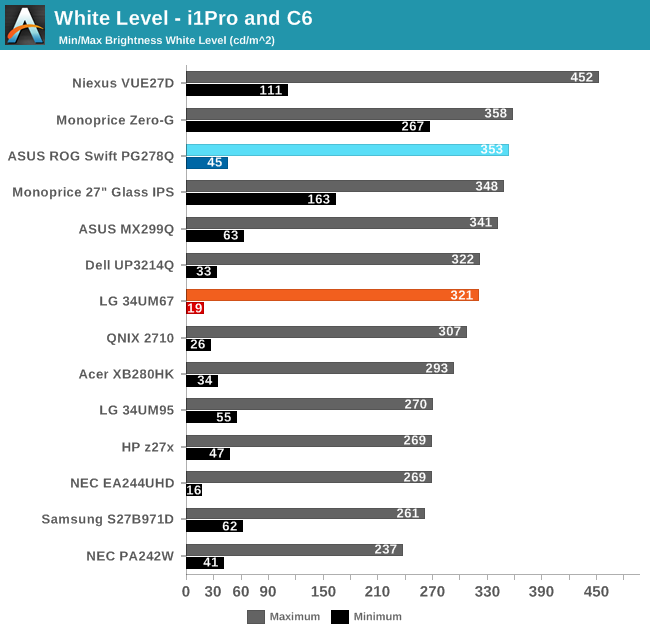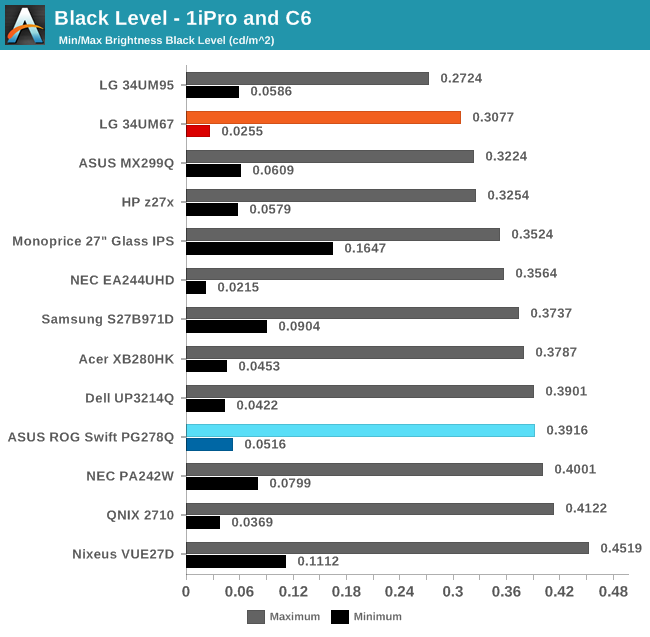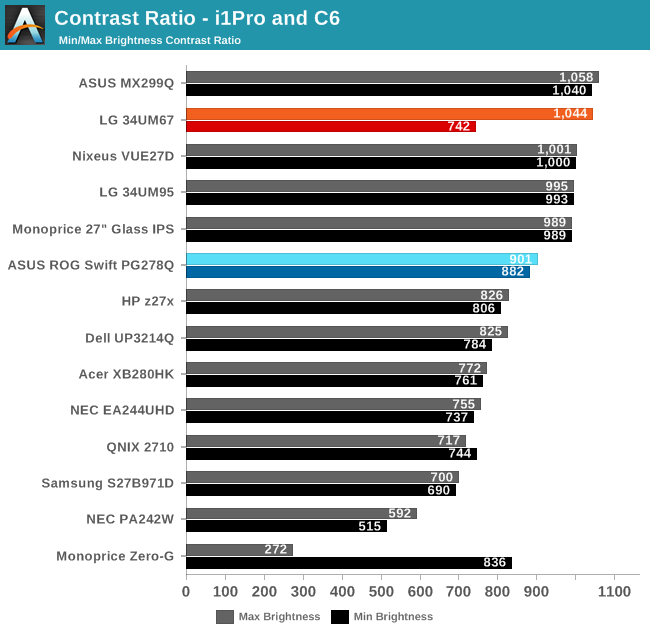LG 34UM67: UltraWide FreeSync Review
by Jarred Walton on March 31, 2015 3:00 PM ESTLG 34UM67 Brightness and Contrast
Moving on from the FreeSync discussion, we still need to see how the LG 34UM67 fares as a display. We’ve run our usual assessments to look at brightness, contrast, color accuracy, and uniformity. We’ll start with the brightness results. The LG FreeSync 34UM67 is in orange/red while we've highlighted the ASUS PG278Q in cyan/blue.

Set to maximum brightness with the default (50/50/50) RGB values, the 34UM67 can output 306 nits, which is just above the rated 300 nits. However, you can increase the output a bit more by maxing out the RGB values at 100, which gives us the above result of 321 cd/m2. This is plenty bright for most people, and more than I would normally need (outside of situations where the display needs to overcome reflections and lights during the day.) Setting the brightness to the minimum level with 50% RGB drops the display to 52 cd/m2, which is perhaps a bit too bright, but if you tweak RGB settings you can get as low as 19 cd/m2. That can work even in very dark rooms, so LG has covered all the necessary output range.

Black levels are okay but nothing amazing. At the maximum backlight (with the OSD Black Stabilizer set to 0 – increasing it will increase black levels somewhat, ostensibly to help you see dark areas in games better), we measured 0.3077 cd/m2. Going to the minimum backlight level this falls down to 0.0255 cd/m2. Interestingly, LG doesn’t appear to be using any form of dynamic contrast, so whether we test with a full screen color or 50% APL patterns makes no difference. That’s a good thing if you’re wondering, as dynamic contrast often ends up being more of a distraction than a benefit (IMO).

The resulting contrast ratios range from just over 1000:1 to closer to 750:1, but the contrast ratio stays pretty consistent until the very lowest brightness settings. Also note that our i1 Pro meter isn’t the most accurate sensor for black levels, so that might contribute to some of the difference. Overall, the contrast ratio is good but not exceptional.










96 Comments
View All Comments
inighthawki - Tuesday, March 31, 2015 - link
You guys really need to get the hardware for measuring input lag. For most displays this would not be a big deal to not know, since most are reasonable for basic activities. But when reviewing a gaming display, this is a pretty critical thing to know.Eidigean - Tuesday, March 31, 2015 - link
I completely agree, input lag is very important. I still use my ZR30w IPS display which does not have a scaler or OSD, and the input lag is much lower than the Dell U3011.From Brian Klug's review...
http://www.anandtech.com/show/4070/dell-u3011-revi...
The U3011's scaler / OSD added 12ms of latency compared to the XR30w.
Souka - Tuesday, April 7, 2015 - link
I game on a 24" Sony CRT computer monitor.... my lag is in nano-seconds. :)(Well, many years ago I was using one)
Kinda miss those screens
willis936 - Tuesday, March 31, 2015 - link
Honestly. It's months overdue. It's arguably one of the most important things to !measure on any display, let alone ones with gamer oriented features (cutting edge adaptive sync technologies).jimjamjamie - Wednesday, April 1, 2015 - link
I'll even disable uBlock for a few weeks to help raise funds.Byte - Thursday, April 2, 2015 - link
Darn almost peed my pants then saw it was only 1080. Was kinda surprised when i saw DP 1.2a and HDMI 1.3 but that explained it. Give us 1440 curved with freesync and its probably pinnacle for easily 5 years till OLEDs take over.okashira - Thursday, April 2, 2015 - link
I would have been embarrassed to post any kind of FreeSync or FreeSync vs Gsync review without exact input lag numbers.blanarahul - Tuesday, March 31, 2015 - link
*sniff* *sniff* Nobody cares about the high contrast ratio VA panels.MrCommunistGen - Tuesday, March 31, 2015 - link
I'd love to pick up a G-Sync or Freesync version of the BenQ BL3200PT if they could pull off even a slightly wider range of refresh rates than we see here in this review. 40Hz to 80Hz would allow them to double strobe every frame at 40Hz or below.Samus - Wednesday, April 1, 2015 - link
Interestingly, what I take away from this review, is AMD screwed up one of the benefits of G-sync, that is, the range of refresh. Even though this monitor is capped at 75hz, ie 75FPS, even with vsync off it should know better than to drop below 60FPS/60HZ because tearing is more annoying than judder at lower FPS because the tearing stays on the screen longer since the refresh rate is lower. That's a real oversight...Personally I just stick with 144hz panels (all of which are TN unfortunately) and always have vsync on. With a powerful enough card that never drops below 60+fps it is butter smooth and looks smooth as butter.